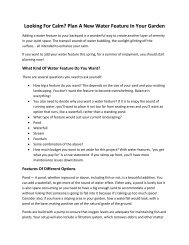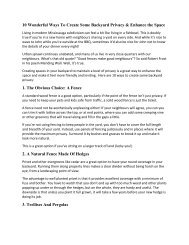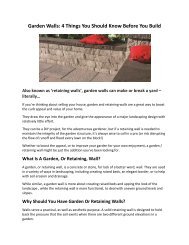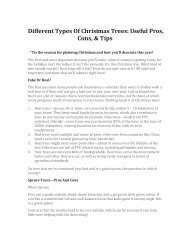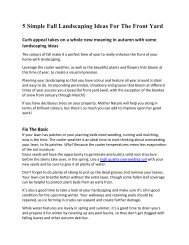Garden Walls: A Primer
Need to select the right type of material to use for your garden wall? Take a look at different pros and cons of concrete & natural stone to select the right one matching your needs – http://www.toemar.ca/garden-walls-concrete-stone/
Need to select the right type of material to use for your garden wall? Take a look at different pros and cons of concrete & natural stone to select the right one matching your needs – http://www.toemar.ca/garden-walls-concrete-stone/
Create successful ePaper yourself
Turn your PDF publications into a flip-book with our unique Google optimized e-Paper software.
<strong>Garden</strong> <strong>Walls</strong>: A <strong>Primer</strong><br />
A well-designed landscape can be inspiring, consider creating visual interest by adding garden<br />
walls. Changing the heights in your garden is one sure way to improve curb appeal on a once<br />
boring, flat yard. A low retaining wall or garden wall might be just what your landscape needs.<br />
Concrete vs Stone walls?<br />
The difference between the |”look and feel” concrete versus stone walls has become more<br />
indistinguishable as technology continues to evolve in concrete forming. Here is a list of pros<br />
and cons for both concrete and natural stone walls.<br />
Concrete <strong>Walls</strong><br />
Modern concrete walls are not the ones you think of in cold, commercial plazas. They have<br />
much improved over the years and come in a variety of shapes, textures and colours allowing it<br />
to blend in well with the yard, garden and the exterior of the house.<br />
Pros<br />
Cons<br />
1. Lightweight – Machinery is usually not necessary when installing concrete garden walls,<br />
most attempting this DIY project are able to lift one or two blocks at the same time.<br />
Concrete products are usually compact and easy to work with.<br />
2. Quick and easy install – The integral lip or tongue-and-groove system interlocks the<br />
blocks and makes the installation fast and easy. You simply drop the blocks in place. Just<br />
be sure to stagger the vertical joints between rows.<br />
3. Versatile design – The shapes that this material comes in allows for curves in the design<br />
and much more versatile than stone.<br />
4. Inexpensive – The cost to make a garden wall out of concrete is less expensive than using<br />
natural stone and is widely available at home centers.<br />
1. Requires a strong and level base – Leveling a concrete garden wall requires more tedious<br />
leveling, it is imperative that your base (4 to 6”) is perfectly level before installing. We do<br />
not want the wall to shift. Unfortunately, this means more digging and base material<br />
required.<br />
2. Cutting with a saw – Cutting is required when installing a concrete garden wall. A special<br />
saw is required to cut these materials during installation.
Stone <strong>Walls</strong><br />
Natural stone (Armour Stone/rock) of different shapes and sizes fit tightly together when<br />
stacked to form a wall. Stones create the nicest-looking walls but are more costly and it will take<br />
much more skill and creativity to build as they are also much heavier.<br />
Pros<br />
Cons<br />
1. Less time is spent on the base when installing Armour Rock because most rocks are not<br />
perfectly level to begin with, most applications do not need tedious leveling.<br />
2. Strength – Strength is one of the biggest reasons why a natural stone wall built out of<br />
Armour Rock is a terrific option for a garden wall, the sheer weight of an individual rock<br />
will make it next to impossible to shift or move.<br />
3. Best-looking – Natural Stone is currently the trendiest option for landscaping; it offers<br />
great curb appeal to all homes. With increased competition within the industry natural<br />
stone is more affordable than ever before.<br />
1. Too heavy – Weight is a problem when using Armour Rock, most of the time a machine<br />
(skid steer) is used when installing Armour Rock.<br />
2. It is much more difficult to install Armour Rock on a tight radius, most of the time you<br />
are limited to straight/linear designs.<br />
3. Harder to work with – Stacking Armour Rock is difficult because of the various heights,<br />
skill and experience is important when selecting specific Armour Rock.<br />
The finished product looks complicated but is a fairly simple project. Be sure to do your<br />
research. Regardless of the material you choose to build your new garden wall, with a little<br />
planning and effort, you will soon have a new focal point in your yard and a new home for your<br />
flowers and plants.<br />
http://www.toemar.ca/garden-walls-concrete-stone/


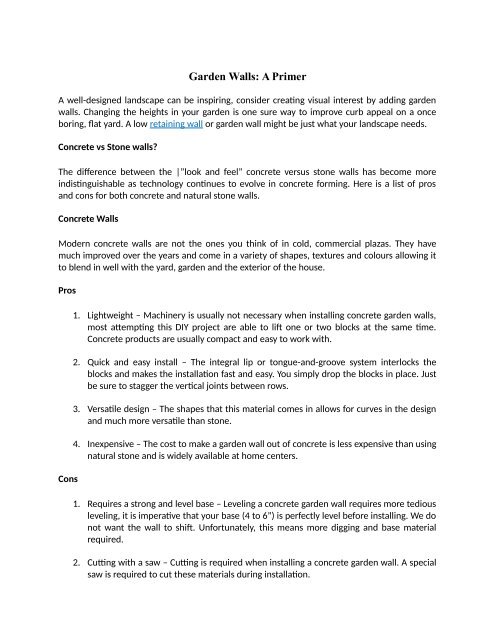



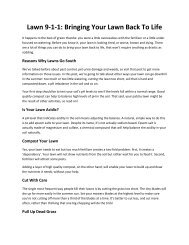


![What’s Hot In Backyard Design in 2018 [6 Tips to an Amazing Yard]](https://img.yumpu.com/60436469/1/190x245/whats-hot-in-backyard-design-in-2018-6-tips-to-an-amazing-yard.jpg?quality=85)
